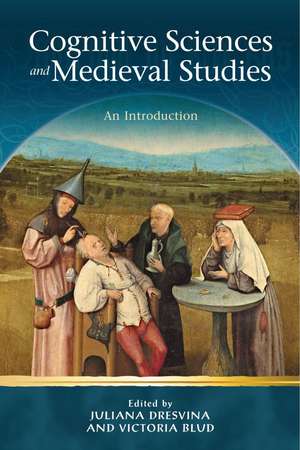Cognitive Sciences and Medieval Studies: An Introduction: Religion and Culture in the Middle Ages
Editat de Juliana Dresvina, Victoria Bluden Limba Engleză Hardback – 27 feb 2021
Preț: 485.31 lei
Preț vechi: 571.46 lei
-15% Nou
Puncte Express: 728
Preț estimativ în valută:
92.87€ • 99.30$ • 77.43£
92.87€ • 99.30$ • 77.43£
Carte indisponibilă temporar
Doresc să fiu notificat când acest titlu va fi disponibil:
Se trimite...
Preluare comenzi: 021 569.72.76
Specificații
ISBN-13: 9781786836748
ISBN-10: 1786836742
Pagini: 336
Ilustrații: 13 halftones
Dimensiuni: 159 x 235 x 23 mm
Greutate: 0.54 kg
Editura: University of Wales Press
Colecția University of Wales Press
Seria Religion and Culture in the Middle Ages
ISBN-10: 1786836742
Pagini: 336
Ilustrații: 13 halftones
Dimensiuni: 159 x 235 x 23 mm
Greutate: 0.54 kg
Editura: University of Wales Press
Colecția University of Wales Press
Seria Religion and Culture in the Middle Ages
Notă biografică
Juliana Dresvina is a member of the History Faculty at the University of Oxford. Victoria Blud is a research associate at the University of York.
Cuprins
Introduction: Cognitive Science and Medieval Studies
Juliana Dresvina and Victoria Blud
I Questions of method
1. How Modular Are Medieval Cognitive Theories? - José Filipe Silva
2. An Unrealized Conversation: Medieval Mysticism and the Common Core Thesis - Ralph Hood Jr
3. Questions of Value: Brain Science, Aesthetics, and Art in the Neurohumanities - Matthew Rampley
II Case studies: histories of neuroscience, psychology and mental illness
4. Neuroscience and the Dialectics of History - Daniel Lord Smail
5. Medieval English Understanding of Mental Illness: Terminology and Symptoms In Comparison to Modern Mental Health Conditions - Wendy Turner
6. Attachment Theory for Historians of Medieval Religion - Julie Dresvina
III Case studies: reading texts and minds
7. ‘A Knot So Subtle and So Mighty’: On Knitting, Academic Writing and Julian of Norwich - Godelinde Perk
8. Making Up a Mind: ‘4E’ Cognition and the Medieval Subject - Victoria Blud
9. Cognitive Approaches to Affective Poetics in Early English Literature - Antonina Harbus
IV Case studies: approaching art and artefacts
10. Medieval Art History and Neuroscience: An Introduction - Nadia Pawelchak
11. Spoons, Whorls, and Caroles: How Medieval Artifacts Can Help Keep Your Brain on its Toes - Jeff Rider
Afterword: The Medieval Brain and Modern Neuroscience - John Onians
Juliana Dresvina and Victoria Blud
I Questions of method
1. How Modular Are Medieval Cognitive Theories? - José Filipe Silva
2. An Unrealized Conversation: Medieval Mysticism and the Common Core Thesis - Ralph Hood Jr
3. Questions of Value: Brain Science, Aesthetics, and Art in the Neurohumanities - Matthew Rampley
II Case studies: histories of neuroscience, psychology and mental illness
4. Neuroscience and the Dialectics of History - Daniel Lord Smail
5. Medieval English Understanding of Mental Illness: Terminology and Symptoms In Comparison to Modern Mental Health Conditions - Wendy Turner
6. Attachment Theory for Historians of Medieval Religion - Julie Dresvina
III Case studies: reading texts and minds
7. ‘A Knot So Subtle and So Mighty’: On Knitting, Academic Writing and Julian of Norwich - Godelinde Perk
8. Making Up a Mind: ‘4E’ Cognition and the Medieval Subject - Victoria Blud
9. Cognitive Approaches to Affective Poetics in Early English Literature - Antonina Harbus
IV Case studies: approaching art and artefacts
10. Medieval Art History and Neuroscience: An Introduction - Nadia Pawelchak
11. Spoons, Whorls, and Caroles: How Medieval Artifacts Can Help Keep Your Brain on its Toes - Jeff Rider
Afterword: The Medieval Brain and Modern Neuroscience - John Onians
Recenzii
“This collection strikes out boldly: refusing to prioritise the sciences as automatically primary in epistemological or methodological terms; exposing the central concept of neuromedievalism to critique; and inviting contributors and readers alike to consider the bases, possibilities, and limits of its capacity to enlighten. The result is enlivening. This fascinating collection offers no simple blueprint for applying cognitive sciences to medieval questions (or vice versa) but rather encourages us to consider what value might be added to each by bringing the two together. There will be some dead ends, it acknowledges, but the potential for mutual enrichment is real and exciting.”






